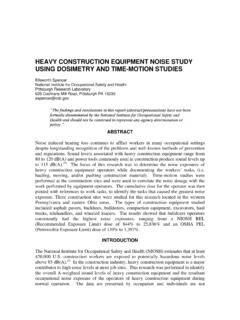Transcription of ARCHITECTURAL CAMPUS PLANNING PRINCIPLES
1 UGA DESIGN & CONSTRUCTION SUPPLEMENTAL GENERAL REQUIREMENTS & STANDARDS ARCHITECTURAL CAMPUS PLANNING PRINCIPLES APRIL 30, 2018 PAGE 1 OF 32 ARCHITECTURAL CAMPUS PLANNING PRINCIPLES INTRODUCTION The purpose of this section of the master plan document is to form a basis for the ARCHITECTURAL character, composition, and typology of future buildings, groups of buildings and exterior spaces on the University of Georgia CAMPUS . This portion of the document aspires to be both a "mirror" and a "lamp." The buildings already existent on the Athens CAMPUS were observed, documented, and analyzed in the course of preparation of this study. Thus the suggestions for future ARCHITECTURAL interventions made herein attempt to reflect the best ARCHITECTURAL traditions evident on CAMPUS . While many aspects of the University of Georgia's CAMPUS make it one of the most memorable compositions of buildings and open spaces to be found in the nation, it is not the purpose of this document to replicate the historic core in order to create a new architecture of empty nostalgia.
2 The University of Georgia CAMPUS forms a collection of buildings from many different time periods and of various styles. There is not a unique "University of Georgia style" per se, rather the notable buildings built over the course of time, reflect both the needs of the moment and the traditions of architecture compatible with the context of the Athens CAMPUS . It is hoped that the insights gleaned from a reading of this section will enable the CAMPUS community to better recognize and understand the ARCHITECTURAL traditions of the CAMPUS , while simultaneously forming a touchstone for architects, landscape architects, planners, and other design working on future projects. Since innovation is always understood relative to some context, the traditions suggested by this portion of the document are intended to "light the way" for future projects. UGA DESIGN & CONSTRUCTION SUPPLEMENTAL GENERAL REQUIREMENTS & STANDARDS ARCHITECTURAL CAMPUS PLANNING PRINCIPLES APRIL 30, 2018 PAGE 2 OF 32 EXISTING UGA BUILDING STYLES VERNACULAR/GEORGIAN/NEO-CLASSICAL Below are some examples of Vernacular/Georgian/Neo-Classical building styles found on the UGA CAMPUS and a brief indication of their characteristics.
3 Examples - Old College - New College - Phi Kappa Hall - Chapel - Demosthenian Hall Observations - Domestic scale unassuming character with exception of the Chapel - Generally more wall than window - Visual tension between proportions of opening and wall ( , the proportions of the wall are often more dominant than the proportions of window) - ARCHITECTURAL elements are often integral to the building s construction - Vertical bay structure and vertically oriented openings - Spartan vocabulary, restrained use of ornament - Pragmatic elements modulate facade ( , downspout, chimneys, entrances) - Facade is not overly deep except when a portico element is added to recognize entry Old College New College Phi Kappa Hall Chapel Demosthenian Hall UGA DESIGN & CONSTRUCTION SUPPLEMENTAL GENERAL REQUIREMENTS & STANDARDS ARCHITECTURAL CAMPUS PLANNING PRINCIPLES APRIL 30, 2018 PAGE 3 OF 32 EXISTING UGA BUILDING STYLES BEAUX-ARTS Below are some examples of Beaux-Arts building styles found on the UGA CAMPUS and a brief indication of their characteristics.
4 Examples - Peabody Hall - Memorial Hall - Business School Observations - Monumental scale compatible with domestic core of CAMPUS - Range of proportion of window to wall - System of ornamentation may not be directly tied to constructional technique, rather it is tied to broader cultural ideals related to building type ( , you know it is a library by its appearance, but what you see may or may not directly be related to how it was built) - Use of sophisticated proportioning systems - Division into 3 parts vertically and horizontally clear hierarchy of parts - Facade is sculpted in 3 dimensions as if carved from a block of clay - Preference for symmetry, however complex overlapping local symmetries are sometimes used to produce localized picturesque effects - Generally incorporates historical references Peabody Hall Fine Arts Building UGA DESIGN & CONSTRUCTION SUPPLEMENTAL GENERAL REQUIREMENTS & STANDARDS ARCHITECTURAL CAMPUS PLANNING PRINCIPLES APRIL 30, 2018 PAGE 4 OF 32 EXISTING UGA BUILDING STYLES MODERN AND TRADITIONAL Below are some examples of Modern and Traditional building styles found on the UGA CAMPUS and a brief indication of their characteristics.
5 Examples - Library - Fine Arts Building Additions - Sanford Hall Observations - A more monumental scale - Recognition of frame construction techniques in aesthetic of vertical surface - Often more window than wall or an equivalent proportion of window and wall - Facade is layered as a series of flat, planar surfaces composed within the constraints of a modest dimension. - System of ornamentation is restrained, however attempts to relate constructional techniques to cultural ideals related to building type ( , you know it is a library by its appearance, and you have an idea of how it was built) - Draws inspiration from history and ideas of contemporary life Main Library UGA DESIGN & CONSTRUCTION SUPPLEMENTAL GENERAL REQUIREMENTS & STANDARDS ARCHITECTURAL CAMPUS PLANNING PRINCIPLES APRIL 30, 2018 PAGE 5 OF 32 EXISTING UGA BUILDING STYLES MODERN AND CONTEMPORARY Below are some examples of Modern and Contemporary building styles found on the UGA CAMPUS and a brief indication of their characteristics.
6 Examples - Chemistry Annex - Georgia Museum of Art Observations - Vertical surfaces are less likely to be designed as facades - Overall massing dictates form buildings less likely to participate in CAMPUS space making - Openings are slots or zones where wall surface is omitted rather than an incised opening - Character of building is particular to the whim of the architect, client, or donor - Building does not necessarily communicate an idea of what it is or how it was built - Unclear hierarchy of parts - Scale is indeterminate - Abstract form preferred over forms of traditional building ( , roofs, walls, doors , windows , are replaced with horizontal planes, vertical planes, and various kinds of apertures) - Preference for asymmetrical massing and the picturesque over symmetry - Notion of the Zeitgeist prevails, history and tradition are devalued draws little upon immediate physical context Chemistry Annex Georgia Museum of Art UGA DESIGN & CONSTRUCTION SUPPLEMENTAL GENERAL REQUIREMENTS & STANDARDS ARCHITECTURAL CAMPUS PLANNING PRINCIPLES APRIL 30, 2018 PAGE 6 OF 32 THE APPLICATION OF AMERICAN CAMPUS PLANNING PRINCIPLES TO THE UNIVERSITY OF GEORGIA The PLANNING PRINCIPLES exhibited on American campuses are truly a unique art form.
7 While the traditions of CAMPUS PLANNING in the United States are closely related to attitudes concerning building and the landscape developed between the 16th and 19th centuries in England, France, and Italy, the application of these PRINCIPLES to the built form of the university is an art form, which evolved principally in this country. The close relationship between built form and the landscape is a characteristic of CAMPUS PLANNING that is the taproot of this art form. From Thomas Jefferson s University of Virginia, to Saarenin s Cranbrook Academy, this tradition remained unbroken until the Second World War. One of the most readily identifiable characteristics of this tradition was the creation of exterior spaces, which could be likened to interior rooms. In the diagram illustrated in Figure 1, a prototypical room is drawn alongside a university quadrangle of similar proportions. Nearly everyone is familiar with the sense of enclosure and protection afforded by a room s bounding surfaces walls enclose space; windows admit light and air while permitting views to the exterior world; doors permit access; and typically there is some element of focus within the room, perhaps a hearth.
8 It is readily evident that every element performs a role supporting the larger notion of room. That is, walls alone do not the room make. The interdependency of elements and the specialized tasks they play relegate elements of the room to hierarchical roles in the overall composition. That is a door to the room will serve to frame a view of the room s principal feature the hearth, and all along the corners of the room will be subservient to both the former and later elements. Likewise, the exterior room of a CAMPUS quadrangle has features, which might be seen as analogous to that of a traditional interior room. The library may dominate the composition in much the same manner as the hearth, while a pair of buildings axially disposed across the quadrangle from this principal feature might serve the same threshold purposes as that of a door. One might readily see that a successful composition of a college quadrangle requires that the buildings operate in concert with one another.
9 Sometimes buildings are called upon to play more assertive roles that of a hero, like the library, or the matching buildings forming the CAMPUS threshold. The heroic buildings, however, require substantial amounts of good soldier buildings to form the backdrop against which these more assertive buildings might be seen. In PLANNING and building a new CAMPUS or on a portion of an existing CAMPUS it is very important to understand the role that individual buildings are required to play. Too many heroic structures would be like a room full of guests all talking at the same time. Too few heroic buildings would be like a party where none of the guests ever arrived a bit of a bore. In PLANNING a successful CAMPUS composition, one seeks to strike a balance between the heroes and the soldiers. Experience has shown that every trustee, donor, president, dean, every department chair, or faculty member, usually like to view their new building as aspiring to be a hero.
10 And, while much might be said of the heroic nature of the common foot soldier, it is recommended that the creation of heroic buildings on college campuses be limited to those building types which embody and relate the most universal and lofty aspirations of the entire institution churches, libraries, places of assembly, etc. UGA DESIGN & CONSTRUCTION SUPPLEMENTAL GENERAL REQUIREMENTS & STANDARDS ARCHITECTURAL CAMPUS PLANNING PRINCIPLES APRIL 30, 2018 PAGE 7 OF 32 Figure 1 Main Library Main Library UGA DESIGN & CONSTRUCTION SUPPLEMENTAL GENERAL REQUIREMENTS & STANDARDS ARCHITECTURAL CAMPUS PLANNING PRINCIPLES APRIL 30, 2018 PAGE 8 OF 32 CAMPUS BUILDING TYPOLOGY THE EDGE-DEFINING TYPE This building type often performs the role of the common foot soldier, but it may also take on heroic assignments. The generic configuration of the type is that of an elongated rectilinear volume.







